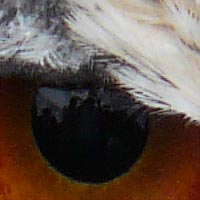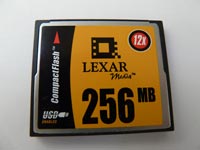Panasonic Lumix DMC-FZ18 Review
Review Date: December 3rd 2007
Author: Gavin Stoker
Leave a comment about this Review
|
Image Quality
All of the sample images in this Review were captured using the 8M Fine (3264 x 2448 pixels) JPEG image size option producing a file that is around 3.5Mb in size.
Noise
The Panasonic Lumix DMC-FZ18 has 6 ISO settings. Under examination image noise presents itself from ISO 200 upwards � which is surprisingly low � though not aggressively so, meaning that if you stick to ISO 800 or below you'll get pleasing results. It's arguable whether you'll want to attempt images at ISO 1250 or ISO 1600 � the latter much more gritty � though it's nice to have them there for use at a push. Here are some 100% crops which show the noise levels for each ISO setting.
ISO 100 (100% Crop) |
ISO 200 (100% Crop) |
 |
 |
ISO 400 (100% Crop) |
ISO 800 (100% Crop) |
 |
 |
ISO 1250 (100% Crop) |
ISO 1600 (100% Crop) |
 |
 |
Sharpening
Here are two 100% crops which have been Saved as Web - Quality 50 in Photoshop. The right-hand image has had some sharpening applied in Photoshop. The out-of-the camera images at the default setting are soft and benefit from some further sharpening in a program like Adobe Photoshop. You can also change the in-camera sharpening level if you don't like the default results.
Original
(100% Crop)
|
Sharpened (100% Crop) |
 |
 |
 |
 |
Chromatic Aberrations
The Panasonic Lumix DMC-FZ18 dealt very well with chromatic aberrations during the review, with only limited purple fringing present around the edges of objects in certain high-contrast situations. Here is a 100% crop which shows the typical chromatic aberrations that you can expect:
|
Chromatic
Aberrations (100% Crop)
|
 |
Macro
The Panasonic Lumix DMC-FZ18 offers a Macro setting that allows you to focus on a subject that is 5cms away from the camera. The first image shows how close you can get to the subject in Macro mode (in this case a compact flash card). The second image is a 100% crop.
|
Macro Shot |
Macro Shot (100% Crop) |
 |
 |
Flash
The flash settings on the Panasonic Lumix DMC-FZ18 are Auto, Auto/Red-eye Reduction, Forced On, Slow Sync./Red-eye Reduction and Forced Off. These shots of a white coloured wall were taken at a distance of 1.5m.
|
Flash Off - Wide Angle (28mm) |
Auto Flash - Wide Angle (28mm) |
 |
 |
|
Flash Off - Telephoto (504mm) |
Auto Flash - Telephoto (504mm) |
 |
 |
And here are some portrait shots. As you can see, both the Auto and Red-Eye Reduction options caused a tiny amount of red-eye.
|
Auto |
Auto (100% Crop) |
 |
 |
|
Flash - Red-Eye Reduction |
Flash - Red-Eye Reduction (100% Crop) |
 |
 |
Night Shot
The Panasonic Lumix DMC-FZ18 maximum shutter speed is 60 seconds in Starry Sky Mode, which is excellent news if you're interested in night photography. The shot below was taken using a shutter speed of 5 seconds, aperture of f/6.3 at ISO 100. I've included a 100% crop of the image to show what the quality is like.
|
Night Shot |
Night Shot (100% Crop) |
 |
 |
Overall Image Quality
We've given recent Panasonic cameras a warm welcome on PhotographyBLOG, and when it comes to assessing the images, the Panasonic Lumix DMC-FZ18 doesn't look like it'll be the one to buck the trend and receive a frosty reception instead. Even when shooting at maximum telephoto on an overcast day, the majority of our images were richly detailed and free of any tell tale softness from hand wobble, suggesting that the built-in MEGA OIS feature cuts the proverbial mustard under most conditions. Under artificial light we did get the occasional soft shot, but a simple re-focus and second fire of the shutter and we had what we were after. For the most part images are well saturated, though not over-saturated, meaning that realistic skin tones are achievable. Pixel fringing between areas of contrast is respectably absent on most occasions. White balance doesn't always get it right however, especially when operating under mixed lighting, but again a simple manual adjustment solves any problems. Exposures are even however and metering generally spot on. Under examination image noise presents itself from ISO 200 upwards � which is surprisingly low � though not aggressively so, meaning that if you stick to ISO 800 or below you'll get pleasing results. It's arguable whether you'll want to attempt images at ISO 1250 or ISO 1600 � the latter much more gritty � though it's nice to have them there for use at a push. It also brings the Panasonic Lumix DMC-FZ18's specification into line with what you'd expect for this class of camera and its asking price.
|
![]() PhotographyBLOG
is a member of the DIWA
organisation. Our test results for the Panasonic Lumix DMC-FZ18 have
been submitted to DIWA
for comparison with test results for different samples of
the same camera model supplied by other DIWA
member sites.
PhotographyBLOG
is a member of the DIWA
organisation. Our test results for the Panasonic Lumix DMC-FZ18 have
been submitted to DIWA
for comparison with test results for different samples of
the same camera model supplied by other DIWA
member sites.
